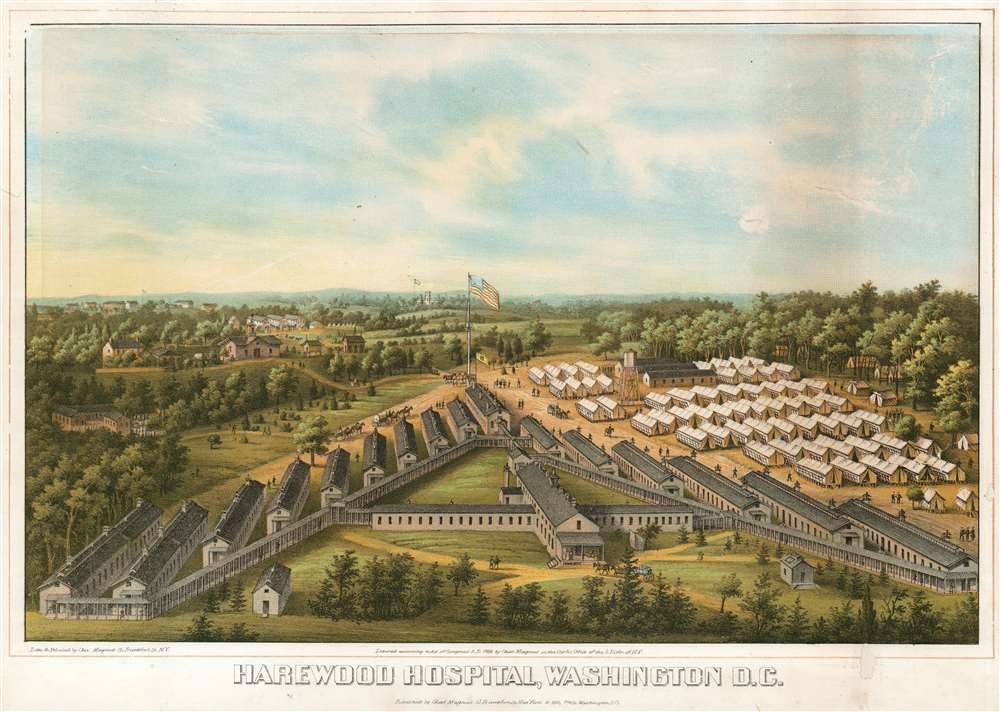This item has been sold, but you can get on the Waitlist to be notified if another example becomes available, or purchase a digital scan.
1864 Magnus Bird's Eye View of Harewood Hospital, Washington D.C.
Harewood-magnus-1864
Title
1864 (dated) 11.75 x 17 in (29.845 x 43.18 cm)
Description
Innovations in Military Medicine
Harewood Hospital was part of the rapid expansion of Union military medicine developed to meet the unprecedented need for medical services resulting from the horrific casualties that characterized the American Civil War. The United States peacetime army had only 113 doctors on staff, nearly a quarter of which joined the secessionists. By the end of the war, the Union Army had more than twelve thousand doctors. Before the war, the only hospital in Washington, DC, was a two-story six-room building. The July 1861 was a small affair compared with the war's eventual bloodbaths, but even that outstripped the medical systems in place. The military had no ambulance corps, and the civilian ambulance drivers fled with the battle's first shots. Abandoned ambulances were commandeered by healthy soldiers fleeing back to Washington, DC. Wounded soldiers, on the other hand, lay on the battlefield for days. By the battle of Antietam - weeks after Harewood was established - the Union had developed a network of 71 field hospitals, channeling wounded to larger general hospitals, like Harewood. These were situated in large cities, and soldiers were transported there from the field hospitals by train or ship. At the end of the war, there were about 400 hospitals with about 400,000 beds. Harewood alone had nine wards of 63 beds each totaling 945 beds, with as many as 312 additional tents added to expand capacity to 1,872 beds.The situation of Harewood in the capital made it easily accessible to visiting notables, among whom were President Abraham Lincoln, Mary Todd Lincoln, and Walt Whitman.
Publication History and Census
During the War, Charles Magnus printed views of many of the Union hospitals and camps both in the form of letterhead writing paper and envelopes and also as separately issued prints such as this. These were very often the only visual records families would have of the places where their loved ones in the military were stationed, but while they were popular they survive poorly, seldom enjoying archival treatment. Consequently, this view is rare. We see only four examples catalogued in OCLC, at the American Antiquarian Society Library, the Boston Athenaeum, The University of California at Davis, and the Clements Library at the University of Michigan.Cartographer
Charles Magnus (1826 - 1900) was a New York City based stationer, illustrator, bookseller, and map and print publisher active in the middle to late 19th century. Magnus was born in Elberfeld, Germany, as Julian Carl Magnus. Fleeing the March Revolution in Germany, the Magnus family immigrated to New York City in 1848. In New York, Charles' brother Carl Emil had already established himself as the editor of a German weekly newspaper, Deutsche Schnellpost. It was through his brother that Magnus learnt the printing and publishing trade. The earliest work to bear the Magnus inscription dated to the 1850s and includes various pictorial broadsides and maps intended to commemorate important events - the most notable for map enthusiasts being his 1855 map of New York commemorating the '79th Year of Independence of the United States'. During the 1860s and years of the American Civil War, Magnus, through various political connections, became one of the few illustrators with unrestricted access to Union military camps. He is consequently particularly well known for his authentic view of Civil War cities, personages, and events. Following the war, Magnus began to develop a prosperous business creating and selling panoramic city views, song sheets, and patriotic envelopes. In all Charles Magnus, with over 1000 known works, was one of the most prolific American printers of broadsides and other lithographs. More by this mapmaker...

